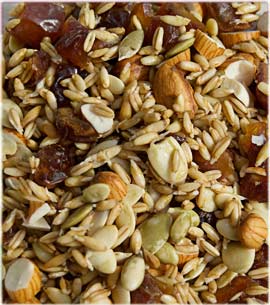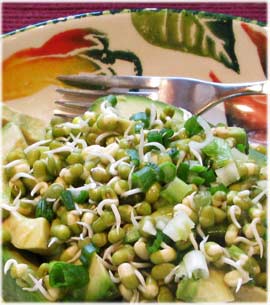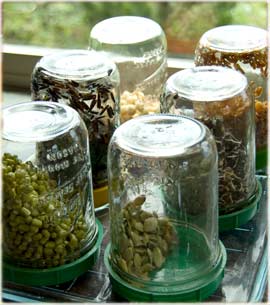 | |
|
Our lives,
so seemingly small, ripple out to the whole universe as tiny whispers like the sounds of butterfly wings, and the clear voice of the living truth. -J.L.D. |

Sometimes we are in awe at how life gives of itself to create more life. This is especially true when we look at jars of sprouts and see thousands of little seeds growing with vigor. And to think we can eat these enzyme rich, high protein foods that are bursting with life force!
Ann Wigmore, author of The Sprouting Book, writes: "Sprouts, while inexpensive and easy to grow, afford one of the most concentrated but truly natural sources of vitamins, minerals, enzymes, and amino acids (protein) known. They are also biogenic—alive—capable of transferring their life energy to your body."
Once we learned how to sprout, which was so much easier than we thought, and found sprouts that we actually liked to eat, we were off and running. The following sprouts have become part of our daily fare: mung bean, garbonzo bean, wehani rice, oats, millet, barley, green lentil, wild rice, quinoa, and alfalfa.
Two of our favorites sprouted dishes are oat granola, and mung beans with avocado and lime juice. To make these at home, you will need wide mouth mason jars (available at grocery stores) with screw-top plastic lids (available through Amazon), or a strainer and a plastic bag. (Explanation follows.)
Raw Oat Granola
 1/2 cup sprouted oats (See "How to Sprout" below) 1/2 cup pumpkin seeds (soaked overnight or for 6 hours) 4 Medjool dates, chopped 12 almonds (raw, or soaked for 6-8 hours) Directions
Chop the dates and the almonds. Divide ingredients into each bowl. Serve as is, or with your favorite fruits, or with a little of your favorite milk.How to Sprout Oats for Making Raw Granola
In the morning, or at night, begin by soaking oats. Make sure you have bought sprouting oats. We love the oats from The Sprout People. Put 1/2 cup oats into a clean wide mouth mason jar and fill with fresh spring or filtered water. Let soak for 6-8 hours. After soaking, attach rinsing lid to jar, and pour off the standing water. Refill jar with fresh cool water, gently swish sprouts, and drain water. Rinse and drain a second time. With the lid still on, turn jar upside down to let all excess water drain out. Sprout with jar upside down in normal room temperatures (65-75 degrees), but away from direct sunlight. Repeat rinsing and draining process the next day. By this time little tails should have emerged and the oats are ready to eat. Refrigerate any extra for several days. Rinse with cool water and drain completely each day. If sprouts get moldy, discard and start again. If you don't have the above equipment sprouting can be done by first soaking seeds in a glass or jar. Pour seeds and soak water into a strainer, rinse with cool water, cover with a plastic bag, and set in a warm place. Then rinse and re-cover twice daily until sprouts are ready. Avocado & Mung Bean Salad
 4 tablespoons (or more) mung bean sprouts. (see "How to Sprout" below) 1 large Hass avocado 1 green onion 2 tablespoons lime juice Himalayan salt, optional Directions
Slice avocado and place on a plate.Sprinkle mung bean sprouts over avocado. Finely chop green onion and sprinkle on top. Squeeze lime juice and pour on top. Sprinkle with a touch of salt. How to Sprout Mung Beans
Put 3-4 tablespoons mung beans into a wide mouth mason jar and fill the jar with fresh water. Soak beans for 8-12 hours. After soaking, attach rinsing lid to the jar, and pour off the standing water. Refill the jar with fresh cool water, gently swish sprouts, and drain water. Rinse and drain a second time. With the lid still on, turn jar upside down to let all excess water drain out. Sprout with jar upside down in normal room temperatures (65-75 degrees), but away from direct sunlight. Repeat rinsing and draining process the next day. Refrigerate when you see little tails. Rinse and completely drain one time each day. Sprouts will keep well for 4-5 days. Note: The mung bean sprouts will not look at all like the kind you buy in the grocery store. The green skins will still be on the sprout, and the tails will be about 1/4 - 1/2 inch long. The flavor is a bit like crunchy, sweet lettuce. If sprouts get moldy, discard and start a new batch. Optional Cilantro Lime Juice Salad Dressing 1/2 cup loosely chopped and packed fresh cilantro (avoid tough stems) 1/4 cup favorite mild tasting oil 1 clove garlic 2 tablespoons water 2 tablespoons fresh squeezed lime juice 1 tablespoon agave nectar Put all ingredients in food processor (or blender), and pulse to desired consistency. A Little Story—The Birth of Our Kitchen Sprout Farm:  Our conversion to eating sprouts has amazed us because we used to really dislike sprouts and never had success growing them. Something happened, a change, and now we've become sprout lovers! So what triggered this shift? It started one day when we bought some beautiful Wehani rice that actually sprouted in two days and tasted delicious. Since we have had trouble eating cooked grains, the possibility of having rice again was exciting. We soon got hooked on the nutty flavor and crunchy/chewy texture, adding the rice to smoothies or making satisfying rice salads. The energy buzz was palpable—almost like drinking coffee without the side effects! This singular success encouraged us to try other sprouts. (Recipe for Wehani Rice Salad will be coming soon.) We bought mason jars, and green plastic sprouting lids (non-mesh variety) from Amazon and ordered seeds from The Sprout People. I was like a woman possessed, creating a small sprouting farm in the kitchen. We couldn't get over the fact that in just a few days we would reap a harvest of the freshest food imaginable—because sprouts are literally eaten while they're still growing! It took a couple of weeks to get accustomed to having sprouts on hand all the time because we'd eat them before realizing we'd passed the "start day" to replenish our supplies. Now we have, at any given time, jars of various seeds, nuts, legumes, grains, either sprouting or soaking, beautiful to behold. For us, the benefits from eating sprouts have been increased energy, increased enzyme and protein intake, improved muscle tone, more joy, and clarity of thought. Gabriel Cousens, MD, speaks of eating raw foods: "On a living-food diet, I have personally found that it is easier to experience an extraordinarily exquisite, gentle eternal flow of the Divine energy coursing through the physical and subtle bodies." Watching the process of sprouts growing before our eyes has enhanced our appreciation of the wonder of nature, and brings a sense of gratitude for the profound gift of life that is giving of itself so that we may live, and thrive!  |









